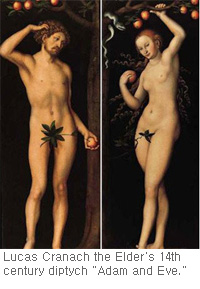 Suit over Norton Simon artwork enters a final phase
Suit over Norton Simon artwork enters a final phase
An art dealer's daughter-in-law appeals to the 9th Circuit to lay claim to the diptych 'Adam and Eve' at the Pasadena museum. It was stolen by Goering in World War II.
A long-running lawsuit to force the Norton Simon Museum to surrender one of its prized artworks, 480-year-old paired paintings of Adam and Eve by Lucas Cranach the Elder that were looted during the Holocaust, has reached what could be its last legal round: plaintiff Marei Von Saher's recent appeal to the U.S. 9th Circuit Court of Appeals.
If her appeal fails, it could have far-reaching implications, potentially undermining a larger class of claims to recover Nazi-looted art.
Von Saher, who lives in Connecticut, contends that the "Adam and Eve" diptych that has hung in the Pasadena museum since the late 1970s remains stolen goods. The paintings had belonged to her father-in-law, Jacques Goudstikker, a prominent Dutch-Jewish art dealer whose holdings were expropriated by one of Adolf Hitler's top henchmen, Hermann Goering, in a forced sale after the family fled the Nazi invasion of Holland in 1940.
A key issue if the case went to trial would be whether Goudstikker's heirs gave up their right to the diptych in what Von Saher contends were unfairly conducted negotiations with the Dutch government after the war.
U.S. District Judge John Walter dismissed Von Saher's suit March 22, ruling that Dutch authorities' handling of the Goudstikker claim more than 60 years ago was consistent with a U.S. policy at the time called "external restitution."
The policy applied to Nazi-looted art, such as "Adam and Eve" and the other Goudstikker-owned works Goering had stolen, that had been recovered by U.S. forces in Europe. Under external restitution, the Army turned over the art to the countries from which it had been looted and left it to each nation's government to conduct a legal process to determine the rightful owners.
Walter dismissed Von Saher's claim after finding that the Netherlands had complied with its obligations under external restitution. He ruled that allowing the "Adam and Eve" case to go forward would improperly circumvent the sole authority over foreign policy that the constitution grants to the federal government.
His ruling hinged on a legal brief from the U.S. solicitor general, saying it's the federal government's position that the Netherlands conducted "bona fide … proceedings" that met the requirements of the external restitution policy and that 60 years later "the United States has a substantial interest in respecting the outcome."
Walter acknowledged that his action could bar other Holocaust-related claims involving stolen art recovered by the U.S. military during and after World War II. The judge wrote that he was dismissing the case "with great reluctance … realizing the effect that this decision may have on victims of the Holocaust and their descendants."
Von Saher's attorney, Lawrence Kaye, said he has filed a notice of appeal with the 9th Circuit, which in 2009 kept her case alive by overturning part of Walter's previous blanket dismissal, citing the statute of limitations.
The statute of limitations is no longer an obstacle because of a California lawthat went into effect in 2010, substantially lowering statute-of-limitations barriers to suits seeking the return of allegedly stolen artworks acquired by California museums or dealers. Walter took the unusual step of adding a footnote to his recent ruling that "the idea for the bill came from Randol Schoenberg," a Los Angeles attorney and art-restitution expert who is on Von Saher's legal team.
 Suit over Norton Simon artwork enters a final phase
Suit over Norton Simon artwork enters a final phase